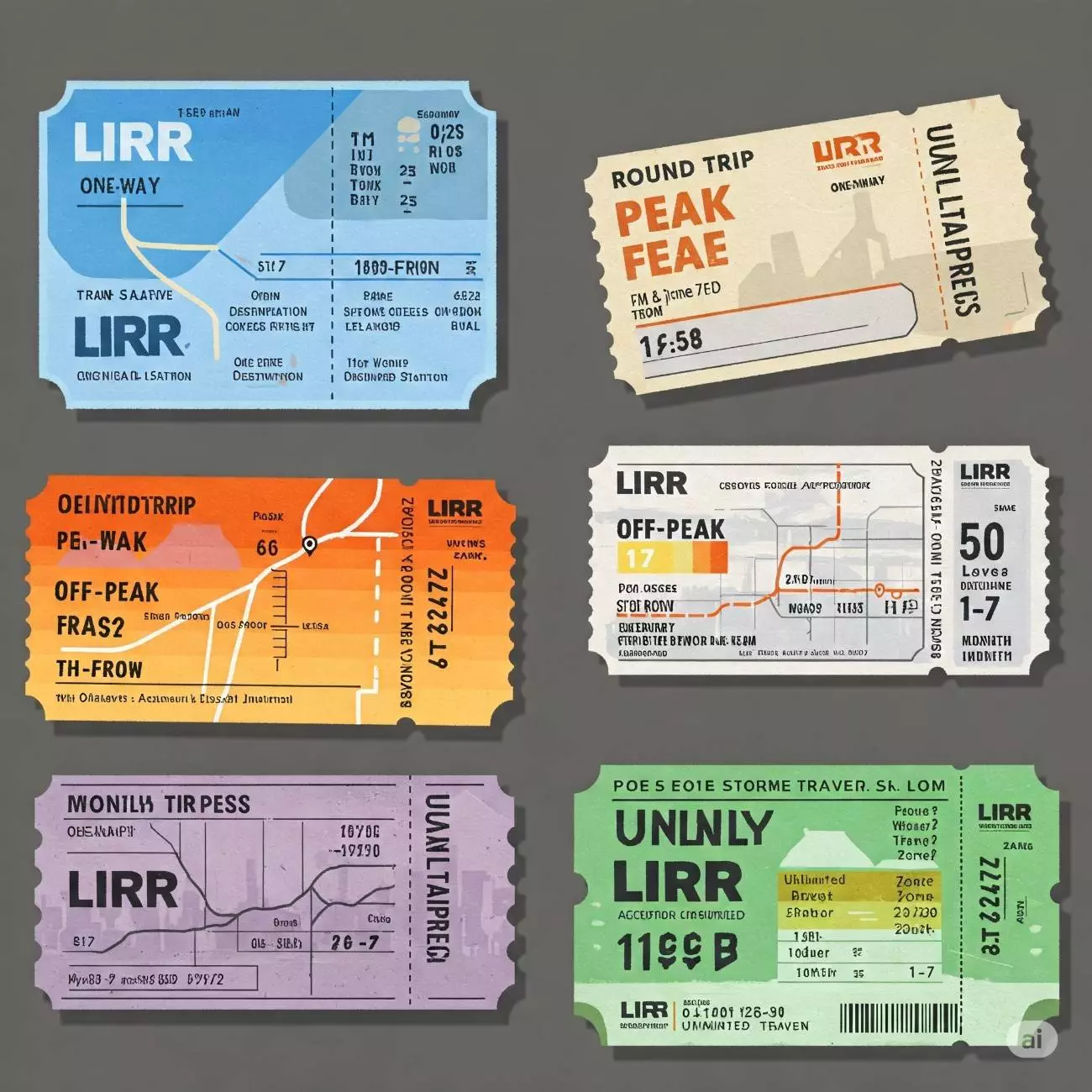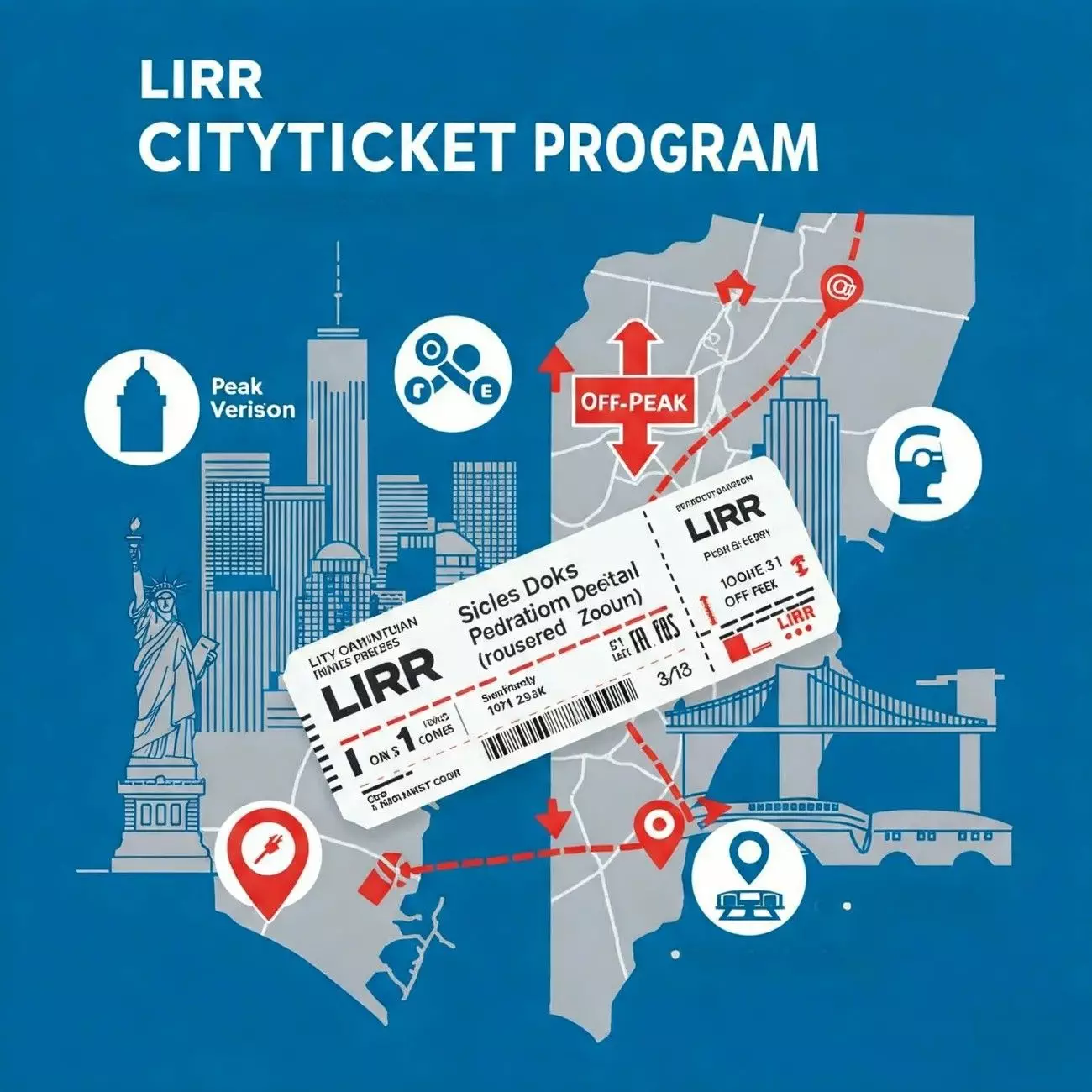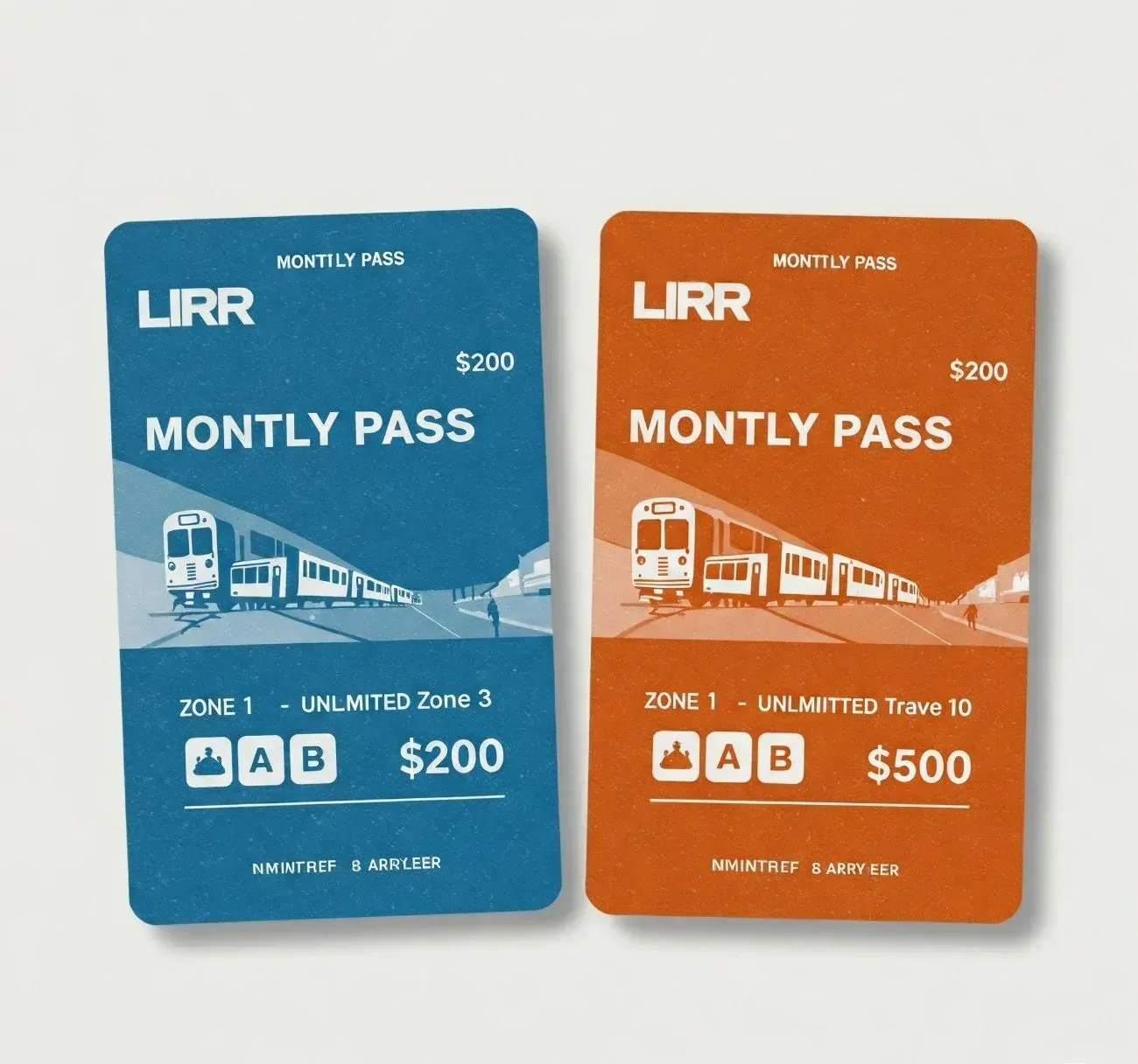Long Island Rail Road (LIRR) operates on a zone system, with fares determined by distance covered. The train network has more than one fare zone, the innermost LIRR zone being Zone 1, and containing important city terminals such as Penn Station and Grand Central in Manhattan. As one moves eastward, the zones are numbered sequentially, covering the areas in Queens, Nassau County, and finally Suffolk County. The most distant areas, like Zones 12 and 14, cover the easternmost regions of Long Island, including Greenport and Montauk.
LIRR consist of a total of 8 non-consecutive zones, fares are determined based on the number of zones passed while commuting. Commuting within one zone is cheaper than passing through multiple zones. The LIRR provides a range of fares, including one-way, round-trip, off-peak, peak, and monthly passes to suit divergent traveling needs. Commuters can use the official LIRR fare zone map published by the MTA to estimate their fares with precision.
You may like:
LIRR Zones
The Long Island Rail Road (LIRR) is divided into fare zones, which determine the price of tickets based on the distance traveled. There are total 8 non consecutive zones in LIRR with zones numbered 1, 3, 4, 7, 9, 10, 12, and 14. These zones are numbered, with Zone 1 covering the area closest to Manhattan and higher numbers indicating locations farther out on Long Island. The fare system is structured such that the more zones you travel through, the higher the cost of your ticket. This system allows for more accurate pricing based on the passenger’s starting and ending locations.

LIRR Zone Map
MTA LIRR fares are depended on the Zones in which we are traveling. Someone traveling within the same zone has to pay same price for any station within same zone on the MTA LIRR zone map and vice versa. But the peak and off peak fares can be changed according to the time on which someone is traveling.
The LIRR Zone Map can be shown in the document: LIRR Zone Map
MTA LIRR Zones
-
Zone 1: It is the City Terminal Zone, which includes Penn Station, Grand Central, and Brooklyn and Queens stations west of Jamaica.
-
Zone 3: This comprises Jamaica and all stations east of Queens except Far Rockaway.
-
Zones 4 through 7: These zones serve stations in Nassau County and Far Rockaway and Belmont Park in Queens.
-
Zones 9 through 14: These zones serve all stations in Suffolk County.

Across each zone, fares are equal, whether inside the same zone or between zones.
LIRR Tickets
| Ticket Type | Valid For | Peak Fare | Off-Peak Fare | Notes |
|---|---|---|---|---|
| One-Way | Single continuous journey | Full fare by zones | 20% discount off peak | Valid for two hours; unlimited transfers within window |
| Round-Trip | Outbound and return same day | ~90% of two one-ways | ~90% of two off-peaks | Return leg must be used same day |
| 10-Trip | Ten one-way rides | ~85% of ten one-ways | ~85% of ten off-peaks | Each ride valid two hours; best for infrequent commuters |
| Weekly Pass | Unlimited travel for 7 consecutive days | Flat weekly rate | Same weekly rate | Use if daily round trips > cost of pass |
| Monthly Pass | Unlimited travel for a calendar month | Flat monthly rate (~16 peak rides) | Same monthly rate | Best for frequent riders; savings increase with usage |
| CityTicket | Any trip wholly within NYC (Zones 1–3) weekends/holidays | $5 per one-way | $5 per one-way | Applies only on weekends & major holidays; no transfers to non-LIRR services |
| Family Fare | Children 5–11, accompanied by adult | 50% of adult fare | 50% of adult off-peak fare | Up to two children under 5 ride free per adult |
| Reduced-Fare Program | Seniors (65+) & customers with disabilities | 50% of adult peak fare | 50% of adult off-peak fare | Enrollment required; RTW and multi-ride passes available at reduced rates |
LIRR Ticket Types
The Long Island Rail Road (LIRR) provides several ticket options, such as one-way, round-trip, peak, off-peak, and monthly passes. O’Hare’s peak rate covers rush hours — when trains are headed toward western terminals from 6:00 a.m. to 10:00 a.m. or leaving from 4:00 p.m. to 8:00 p.m.
CityTicket Program
Discounted fares are also available within New York City under the City Ticket program:
- Off-Peak City Tickets: $5
- Peak City Tickets: $7
City Tickets are also two-zone valid in Zones 1, 3. A Rockaway Ticket, a special ticket is also available for the same price as a CityTicket between Manhattan and Brooklyn to/from Far Rockaway.
Monthly Passes
There are monthly unlimited passes for various combinations of zones, and fares are determined by the number of zones covered.
- A monthly pass from Zone 1 to Zone 3 is $200
- A pass from Zone 1 to Zone 10 is $500
Passengers can choose the cheapest ticket type depending on their journey needs through this zonal fare system.

LIRR Fare Zones and Key Stations
This table summarizes all the zones and their key stations. Each zone represents a different geographical area, ensuring fares are based on the distance between the stations.
| Zone | Stations |
|---|---|
| Zone 1 | City Terminal Zone (Penn Station, Grand Central, Atlantic Terminal, Long Island City, Hunterspoint Avenue, East New York, Woodside, Forest Hills, etc.) |
| Zone 3 | Eastern Queens (Jamaica, Hollis, Queens Village, Flushing–Main Street, Bayside, Douglaston, Little Neck, etc.) |
| Zone 4 | Nassau County & Far Rockaway (Gibson, Hewlett, Woodmere, Cedarhurst, Valley Stream, Lynbrook, Far Rockaway, etc.) |
| Zone 7 | Nassau County (Long Beach, Rockville Centre, Baldwin, Merrick, Bellmore, Wantagh, Seaford, Massapequa Park, Amityville, Copiague, Lindenhurst, etc.) |
| Zone 9 | Western Suffolk County (Brentwood, Central Islip, Sayville, Patchogue, Bellport, Mastic Beach, Speonk, Hampton Bays, Southampton, Bridgehampton, etc.) |
| Zone 10 | Mid-Suffolk County (Ronkonkoma, Islip, Oakdale, Sayville, Patchogue, Bellport, Mastic–Shirley, Mastic Beach, Hampton Bays, Southampton, Bridgehampton, etc.) |
| Zone 12 | Suffolk County (Montauk, Greenport, East Hampton, Amagansett, etc.) |
| Zone 14 | East End (Montauk, Southampton, Bridgehampton, and other stations on the eastern end of Long Island.) |
How Zone Based LIRR Fare Systems Work and Why They Matter?
Zone-based fare systems are a typical method of charging for public transport, particularly in big cities. These systems split the city and suburbs into geographical “zones”, and the price a rider pays is based on how many zones they pass through.
What Are LIRR Fare Zones?
Fare zones are designated areas employed by transport authorities to determine ticket charges. When a rider moves from one location to another, the total fare relies on the zones traversed during the journey. The system is created so that it can indicate the distance covered—greater journeys involving more zones usually cost more than smaller journeys within a single zone.
How LIRR Fares Are Calculated
The price rises with the number of zones covered. For instance, if a passenger begins in Zone 1 and ends in Zone 3, they’ve covered two zones. The price will be more than if they were traveling within Zone 1 alone. This makes sure that people who travel further pay more, which offsets system usage and operating expenses.
LIRR Fare Increases [Applicable from January 2026]
MTA LIRR authority has proposed the increase in fare prices which will be applicable from January 2026. Monthly fares are increased by 4.4% while daily fares were increased upto 8%.
| LIRR Zone | Current Monthly Fares | Proposed Fares | Change |
|---|---|---|---|
| 1 | $165.00 | $172.50 | $7.50 |
| 3 | $198.00 | $207.00 | $9.00 |
| 4 | $253.00 | $264.25 | $11.25 |
| 7 | $287.00 | $299.75 | $12.75 |
| 9 | $341.00 | $356.50 | $15.50 |
| 10 | $378.00 | $394.50 | $16.50 |
| 12 | $433.00 | $452.00 | $19.00 |
| 14 | $468.00 | $487.75 | $19.75 |
Frequently Asked Questions
1. What are LIRR zones and how do they function?
LIRR zones are geographical areas that help establish fare costs. The further you travel in zones—from Zone 1 (Penn Station) out to Zone 14—the more you’ll pay.
2. How many LIRR zones are there?
There are 14 fare zones on the LIRR. Zone 1 has Penn Station and Atlantic Terminal, and zones continue numerically the further you travel from NYC, up to Zone 14.
3. How does LIRR determine fares by zones?
Fares depend on how many zones you cross. For instance, a trip from Zone 1 to Zone 4 (Carle Place) will cost less than a trip from Zone 1 to Zone 10 (Riverhead).
4. What zone is Carle Place on the LIRR?
Carle Place station is in Zone 7.
5. How much is the fare from Zone 1 to Zone 10?
The fare from Penn Station (Zone 1) to Zone 10 varies based on ticket type (peak, off-peak, monthly, etc.). For instance, a peak one-way fare would cost approximately $17–$20, whereas a monthly ticket may cost more than $400.
6. Is there a map indicating all LIRR fare zones?
Yes, the MTA offers an official LIRR fare zone map, which displays all stations and their respective zones. It’s found on the MTA website.
7. Are LIRR fares equal to Metro-North fares?
Both operate with zone-based fares, but Metro-North travels to areas north of NYC, and LIRR travels to Long Island. They are comparable, but Metro-North could have slightly adjusted fare zone boundaries and fare ranges.
8. In which LIRR zone is Port Washington located?
The Port Washington station is located in Zone 4 on the LIRR.
9. Were there any changes to LIRR fares or zones in 2016–2019?
Yes, LIRR fares have been regularly changed with the fare increases and policy revisions. Yet, the real zone definitions have remained roughly the same by and large.
10. How can I conserve money on LIRR fares?
Think about buying off-peak, 10-trip tickets, monthly passes, or traveling with MTA promotions such as CityTicket (traveling within NYC). Purchasing tickets through the MTA TrainTime app also saves money compared to onboard purchases.
